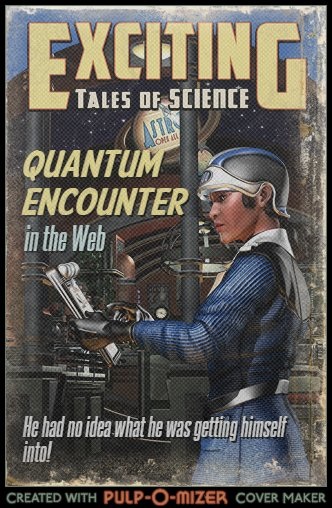Stanford online quantum mechanics
In September 2014, I embarked on the Stanford online quantum mechanics course by Prof. David Miller,
Quantum Mechanics for Scientists and Engineers
Just when I thought “I’ve done it!”, a sequel
Quantum Mechanics for Scientists and Engineers 2
was announced, from January to March 2015. It too seemed essential, and I decided to continue. Now that I’ve finished both courses, here is a quick review, including the overall syllabus, and an account of my personal experience.

Syllabus of the Stanford online quantum mechanics courses
First course, September – December 2014:
- Schrödinger’s wave equation
- Diffraction by two slits
- Particles in potential wells
- Solutions of the time-dependent Schrödinger equation
- The coherent state
- Wave packets, group velocity
- Quantum-mechanical measurement
- Expectation values and operators
- Time evolution and the Hamiltonian
- The uncertainty principle
- Dirac notation
- Unitary and Hermitian operators
- Angular momentum
- Spherical harmonics
- The hydrogen atom
- Perturbation theory
Second course, January – March 2015:
- Quantum mechanics in crystals: band structure etc.
- Optical absorption in semiconductors
- Electron spin
- Quantizing the electromagnetic field
- Fermions and bosons
- Creation and annihilation operators
- Spontaneous and stimulated emission
- Mixed states and the density matrix
- Quantum measurements and encryption
- Quantum computing, teleportation and entanglement
- Hidden variables and Bell’s inequalities
- Interpretation of quantum mechanics
Delivery of the courses
Every week, there where video lectures, about 90 minutes in total. Most lectures were followed by a quiz, and at the end of each week came a graded test. The quizzes and the tests where multiple choice, carefully designed so that one couldn’t score highly just by guessing. Many of the questions were aimed at conceptual understanding. Quite a few others asked for results of calculations.
There were also ten optional, non-graded lectures on the background mathematics.
My personal experience with the courses
I’m sure the difficulty of these courses, and the workload, differ wildly depending on the students background. I can speak only of myself here. I have a good mathematical background, though I’m not specialized on the kind maths that prevails in physics, like differential equations, Taylor series, etc. I knew little about quantum physics before the course. But I had studied some classical mechanics.
As the syllabus shows, the course covers a lot of ground. I’m glad I had looked at classical mechanics before, that may have kept me anchored.
Most of the lectures where clear and as simple as the material permitted.
In a small number lectures, I struggled for orientation. This happened typically when there were references to other areas of physics I hadn’t looked at. For example I haven’t studied electromagnetism yet, and there were lectures about quantizing the electromagnetic field. While I could follow much of that, some notions meant little to me, like ‘magnetic dipole moment’. In those cases, I ended up understanding most of the maths, but lacking a clear understanding of the physical meaning. In particular, I sometimes could not envisage experiments that illustrate these concepts.
Despite these hiccups, I repeat that most of the lectures were clear and helpful.
Against to the large scope of the lectures, the quizzes and tests were short and easy. During my university life I have seen many lectures with simpler content and harder exercises. In some discussion, Prof. Miller mentioned that the main focus was on conceptual understanding. This explains why the exercises involve no very challenging calculations.
On average, I spent maybe six hours per week on the course.
Quantum mechanics vs. classical mechanics from a learning point of view
Independently of this particular course, I learned a lot about the didactic difference between classical mechanics and quantum mechanics:
In classical mechanics, one may encounter hard maths; but one has usually a clear idea of the real life phenomena. For example, it may be hard to calculate the trajectory of a bouncing elastic ball. Or there may be no analytic way to deal with the three-body problem. But these things can be pictured easily in the mind.
In quantum mechanics, the maths is not particularly hard, because it is based on linear algebra. But the wave nature of things can be disorienting. For example, an electron can be seen as a moving wave packet that results from a superposition of single-frequency waves. Each of those single-frequency waves moves at a certain speed, the ‘phase velocity’; but the whole electron is construed to move at a different speed, the ‘group velocity’, which results from the superposition. Also, the electron is not clearly localized in space. Now imagine a discussion of a crystal that contains many electrons. As you see, it’s easy for a beginner to get lost when trying to visualize these things. (Ultimately, electrons in a crystal are accounted for by a ‘band structure’, which is very different from a bunch of classical particles moving about.)
Conclusion
So, was this course worth the extensive burning of midnight oil after my day job? Well, my motivation was to fill white spaces on my mental map of science, and to learn more about the inner workings of nature. I think this was mostly a success. Some things I understood very well, like the hydrogen atom. Others things I still need to understand better, like electromagnetic fields. But I have surely learned how quantum mechanics ticks. Now I only need to stay in touch with the material, lest it fade from my memory…